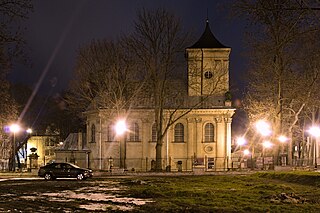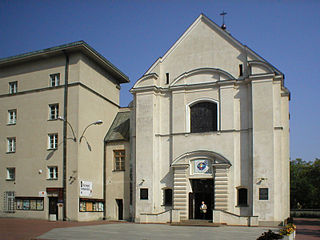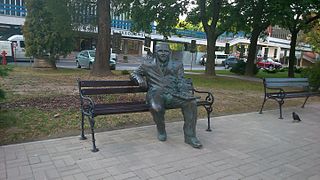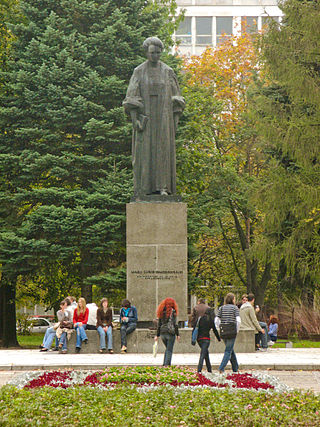Self-guided Sightseeing Tour #4 in Lublin, Poland
Legend
Guided Free Walking Tours
Book free guided walking tours in Lublin.
Guided Sightseeing Tours
Book guided sightseeing tours and activities in Lublin.
Tour Facts
1.9 km
11 m
Experience Lublin in Poland in a whole new way with our self-guided sightseeing tour. This site not only offers you practical information and insider tips, but also a rich variety of activities and sights you shouldn't miss. Whether you love art and culture, want to explore historical sites or simply want to experience the vibrant atmosphere of a lively city - you'll find everything you need for your personal adventure here.
Activities in LublinIndividual Sights in LublinSight 1: Pałac Lubomirskich
The Lubomirski Palace or the Radziwiłłowski Palace – a palace in Lublin erected in the Baroque style, then rebuilt in the Classicist style. The history of the building dates back to the sixteenth century, and its current appearance is due to the reconstruction of 1829. It is located on Litewski Square between the Czartoryski and Gubernialny palaces.
Sight 2: Pomnik Unii Lubelskiej
The Union of Lublin Monument is a monument on Litewski Square in Lublin, erected according to the concept of Stanisław Staszic, designed by Feliks Bentkowski and Paweł Maliński, unveiled on 26 August 1826. It commemorates the union of the Crown of the Kingdom of Poland with the Grand Duchy of Lithuania concluded in Lublin on 1 July 1569. The monument was erected in the place where the nobility came to the Sejm camped and where the sessions took place, opposite the present church and the Capuchin monastery. It is one of the three Lublin sites recognized in March 2007 by the European Union as a symbol of European heritage. At the monument there is the final stop of the Jagiellonian Trail of the Union of Lublin, which leads from the Lublin Castle.
Sight 3: Holy Trinity Church
The Church of the Holy Trinity in Lublin is a parish church belonging to the Diocese of Warsaw of the Evangelical-Augsburg Church in Poland.
Sight 4: Kościół pw. Świętego Krzyża
The church of the Holy Cross in Lublin - the Roman Catholic church of the Holy Cross at Idziego Radziszewskiego 7 in Lublin, in the Archdiocese of Lublin. The original church was created according to legend in 1434, when the Gdańsk merchant Henryk tried to steal the Lublin relic of the Holy Cross tree from the Dominican church. Under the cover of the night he wanted to take a relic from the city, but outside the walls of the oxen they stood and did not want to continue to pull the car. The terrified Henry turned to the city, gave the relic, and then founded a wooden church in a miraculous event. The original church existed until the beginning of the 17th century, when the councilors of Lublin wanted to create a second parish in the large city at the time, and therefore on the site of the old wooden church of St. The cross was issued by a new, brick. The creation of the second parish in Lublin did not occur then, in return, the personal state of the clergy of the Lublin parish church was increased. Michał, and the church of St. At the end of the 17th century, the cross was taken over by the Dominicans of observers who built a monastery next to it. The monks stayed here to the Third Partition of Poland, after which the Austrian government deleted "non -usable" monasteries. The Lublin monastery of the Dominican observers was turned into barracks, expanding it significantly. Barracks so -called Świętokrzyskie was located in it until the beginning. The 1920s, when the buildings were put into use to the newly established University of Lublin, which is still there. In the interwar years, the band's buildings, especially the church, were renovated and partly rebuilt under the direction and according to Marian Lalewicz's projects.
Sight 5: Ławeczka Henryka Raabego
The bench of Henryk Raabe, the first rector of the Maria Curie-Skłodowska University, is located in Lublin on the square named after the patron of the University, on the campus of the Maria Curie-Skłodowska University. The author of the monumental sculpture is the sculptor Benedykt Popek from Masuria in the Podkarpackie region.
Sight 6: Pomnik Marii Curie-Skłodowskiej
The Maria Skłodowska-Curie Monument is a bronze statue in Lublin, eastern Poland, dedicated to Polish physicist and chemist Marie Curie (1867–1934).
Share
Disclaimer Please be aware of your surroundings and do not enter private property. We are not liable for any damages that occur during the tours.
GPX-Download For navigation apps and GPS devices you can download the tour as a GPX file.





